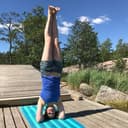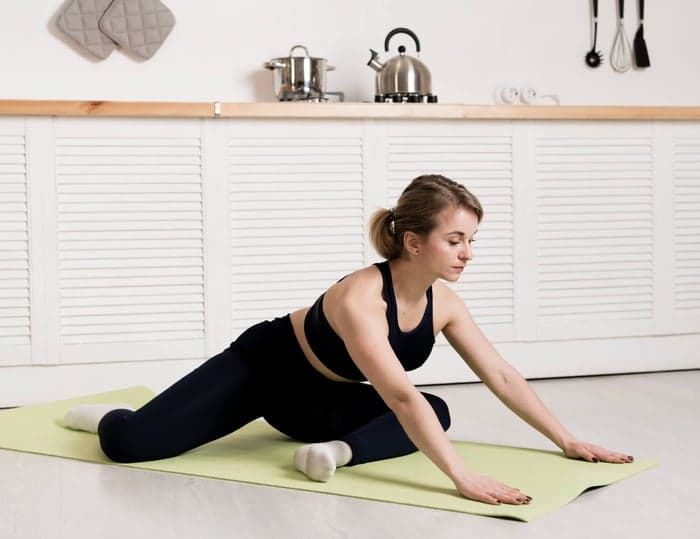
Yoga for Hip Pain: Best Poses, Safety Tips, and Video Routine
Table of Contents
Do your hips feel stiff and cranky after sitting too long? Or maybe there’s a nagging discomfort that shows up when you bend, stretch, or try to get comfy in bed.
For at least 1 in 10 adults, hip pain is more than just a minor inconvenience. It can mess with your daily routine, your sleep, and even your mood.
The good news is that yoga can help you find relief, improve your range of motion, and have a better quality of life.
But with so many routines and pose lists online, it’s hard to know where to start — or which yoga exercises work for your kind of hip pain. Should you stretch more? Focus on strength? Or skip hip opener exercises altogether?
This piece will address all your questions. You'll get:
Science-backed explanations for what might be causing your hip pain
Gentle, feel-good yoga poses to release tension and build strength
Smart modifications so you can meet your body where it’s at
Poses to avoid when your hips are feeling tender
Want to get started right away? Try this gentle 10-minute class to gently strengthen your hips and release tension: Happy Hips with Rishin Paonaskar.
Why Do Your Hips Hurt?
As a yoga instructor, I can't count the number of times I've heard this question: “Why do my hips hurt?” Hip pain can be caused by several issues, such as:
Common Causes of Hip Pain
Arthritis: Over time, the cartilage in your hip joints can wear down, leading to inflammation, stiffness, and a reduced range of motion.
Bursitis: Inflammation of the bursa sacs usually causes a sharp pain in the outer hips, especially when lying down or walking up stairs.
Muscle imbalances: Weak gluteal muscles or a dominant rectus femoris (thigh muscle) can throw off your hip alignment, leading to tightness and instability.
Injuries: Old strains, recent falls, trauma to the hip rotators, and even referred pain from the lower back can create chronic pain if left untreated.
Sedentary lifestyle: Long hours of sitting, especially with poor posture, can weaken your hip flexors, leading to stiffness, limited hip mobility, and increased pressure on the front of the hips.
Diagnosis Before Yoga
While it's tempting to dive right into yoga, hoping it’ll fix everything, before you start stretching out on the mat, it’s crucial to know what’s going on in your hips.
A simple way to feel it out is to figure out if you're dealing with muscle tightness or joint degradation.
Muscle tightness usually shows up as stiffness or pulling when you move. It can get worse when you sit too long, but feels better with gentle movement, breath, and a little stretch.
Joint degeneration, on the other hand, often feels deeper and more achy. You might notice clicking, locking, or a loss of hip mobility, and it may feel worse after resting or first thing in the morning.
If you’re unsure, it’s best to check in with a physical therapist or healthcare provider first. That clarity can make your yoga therapy safer and more effective.
New to yoga? You might enjoy this roundup of the best yoga apps for beginners, including what to look for and how to choose one that suits your needs and goals.
Why Yoga Works for Hip Relief
Yoga isn’t just stretching. It’s an integrated approach for both relieving pain and preventing further injury.
The benefits of yoga for hip health include:
Gentle Stretching: Yoga stretches hip flexors, adductors, and outer hip muscles. It counteracts the tightness from prolonged sitting and muscle imbalances, restoring hip flexibility and comfort.
Strength Building: Yoga activates and strengthens the supporting muscles, especially the hamstrings and core, giving the hip joints necessary stability and protection.
Improved Range of Motion: Yoga poses target fascia and supporting structures around the hips, improving joint mobility and blood flow, while promoting smoother and more flexible hip movement.
Mindful Movement: Yoga’s focus on breath and slow movement calms the nervous system, lowering stress and reducing overall muscle tension, which is critical for chronic pain sufferers.
The research supports this as well. A recent clinical study found that consistent yoga practice can reduce hip pain and stiffness by 30–50% in just six weeks, especially when combined with mindful strengthening movements for the gluteal and core muscles.
How Yogaia Can Help You
If you’ve been trying to manage hip pain but aren’t sure which stretches to do, how long to hold them, or when to modify the poses, you don’t have to try to figure it out on your own or sign up for an in-person class. Yogaia can be your at-home yoga companion.
Through our app, you get access to expert-led yoga sessions specifically designed to relieve hip tension, build strength, and improve mobility. So, no guesswork and no one-size-fits-all routines. Rather, you will be able to:
Practice with the right form and modifications tailored for your hip condition
Access a variety of classes, including gentle stretches, strengthening exercises, and mindfulness practices; and
Build a consistent and safe yoga routine from the comfort of your home
All of the videos shared in this article — including the Happy Hips class — are led by Yogaia’s certified teachers. With over 3,000 live and on-demand sessions to choose from, the platform offers everything from targeted mobility flows to beginner-friendly yoga, yin, and restorative classes. It’s a great resource for anyone managing hip tightness, recovering from injury, or looking for safe, supportive movement options at home.
Here's What One Yogaia User Has to Say:
"A couple of years ago, I had an accident where I took a hard hit to my left hip, shoulder, and head. None of the bones were broken, but the hip radiated intense pain down the entire leg. I had to stay still and avoid moving because of the pain. As a result, my body became imbalanced, and my left side stiffened. Alongside physical therapy, relaxing yoga, Yin, and meditation classes on Yogaia helped me regain balance! I've never looked back since." — Arja, 67, member since 2015
Many users like Arja have found Yogaia to be more than just a yoga app. It’s a trusted support system for long-term hip comfort, recovery, and movement confidence.
Make Space for You
It’s time to prioritise your wellbeing—on your terms. Yogaia makes it simple to start.
Start Your Free Trial →
Best Yoga Poses for Hip Relief
For Stretching
These poses help release tension in tight hip flexors, glutes, inner thighs, and outer hips, improving hip mobility without pushing into pain.
1. Supine Figure-Four (Reclined Pigeon)
This gentle stretch targets the external hip rotators and glutes, making it a go-to for soothing sciatic pain.
Best for: Outer hip pain, tight glutes, sciatic relief
Skip if: You’ve had recent hip surgery or intense low back pain
How to do it:
Lie on your back with knees bent, feet flat.
Cross your right ankle over your left thigh, making a “4” shape.
Gently pull your left thigh toward your chest until you feel a stretch in your right outer hip.
Hold for 30–60 seconds, then switch sides.
Modifications: Use a yoga strap behind the thigh or keep the left foot on the ground if reaching feels uncomfortable.
2. Butterfly Pose (Baddha Konasana)
This pose gives the hip adductors a gentle stretch and supports hip flexibility over time.
Best for: Tight inner thighs, gentle groin opening. It is also a good warm-up.
How to do it:
Sit tall, bring the soles of your feet together with knees bent out to the sides.
Hold your ankles and let the knees fall gently toward the floor.
Sit on a folded blanket if your hips feel tight.
Modifications: If you feel a strain in the groin, don’t hesitate to support the knees with yoga blocks.
3. Seated Twist (Ardha Matsyendrasana)
This calming twist helps release the outer hips and massage the spine.
Best for: Outer hips, spine, and lower back relief.
Skip if: You have spinal injuries or herniated discs.
How to do it:
Sit tall with legs extended.
Bend one knee, placing the foot outside the opposite thigh.
Hug your knee and gently twist toward the bent leg.
Inhale to sit taller, exhale to deepen the twist.
Modifications: Extend your bottom leg if stacking feels too intense.
4. Happy Baby (Ananda Balasana)
Gently opens the hips and helps relieve lower back tension.
Best for: Low back tension, gentle hip opening
Skip if: You’ve had a hip replacement or have limited mobility.
How to do it:
Lie on your back and pull your knees toward your chest.
Grab the outer edges of your feet, keeping your ankles over your knees.
Gently draw your thighs toward the mat.
Modifications: Hold your shins or use a strap if your feet feel out of reach.
5. Chair-Supported Pigeon Pose
It is a gentler, seated version of Pigeon that works well if you're in recovery or spend long hours sitting.
Best for: Beginners, limited mobility, tight hips
How to do it:
Sit tall in a sturdy chair.
Cross your right ankle over your left thigh (just above the knee).
Keep your right foot flexed and your spine long.
Hinge forward gently until you feel a stretch in the outer hip.
Modifications: Use props for support under your foot or hips. Keep the cross lower if needed.
For Strengthening the Hips
These poses help support your hip joints by building strength in your glutes, hip flexors, core, and surrounding supporting muscles, which is essential for long-term hip health.
6. Supported Bridge Pose (Setu Bandha Sarvangasana)
Lifts and strengthens your hips while opening up the front of your body.
Best for: Weak glutes, tight front hips
Skip if: You have unmanaged low back issues
How to do it:
Lie on your back, knees bent, feet hip-width apart.
Press into your feet and lift your hips.
Place a block under your sacrum and relax.
Hold for 30–90 seconds.
Modifications: Use the lowest block height and avoid over-arching your lower back.
7. Warrior I (Virabhadrasana I)
A strong standing pose that builds stability in your hips, legs, and more.
Best for: Quad and thigh stretch, gentle hip rest
Skip if: You have knee pain or limited knee mobility
How to do it:
Start standing (Mountain pose). Step your left foot back 3–4 feet, turning your back toes out about 45 degrees.
Bend your right knee over your right ankle until your thigh is almost parallel to the ground.
Keep your back leg straight, pressing into the outer edge of the back foot.
Square your hips and shoulders to the front. Inhale and lift your arms overhead, reaching up but keeping your shoulders relaxed.
Modifications: Shorten your stance or bring your feet wider for more balance. Also, keep your hands on your hips if reaching overhead is uncomfortable.
8. Hero Pose (Virasana)
A seated stretch that helps you slow down and breathe while stretching your thighs and knees.
Best for: Quad and thigh stretch, gentle hip rest
Skip if: You have knee pain or limited knee mobility
How to do it:
Kneel with knees together, feet wider than your hips.
Sit back on a block or folded blanket between your feet.
Keep spine tall and shoulders relaxed.
Modifications: Raise your seat as much as needed. Never force your knees into discomfort.
Want to support your hips even more? Check out these 12 leg mobility exercises to help improve overall lower-body movement and reduce stiffness.
Yoga Poses to Avoid If You Have Hip Pain
Some popular moves can put too much pressure on the joints, overstretch muscles, or even aggravate certain conditions like bursitis or hip impingement.
Here’s a quick guide to poses you might want to skip:
1. Pigeon Pose (full variation)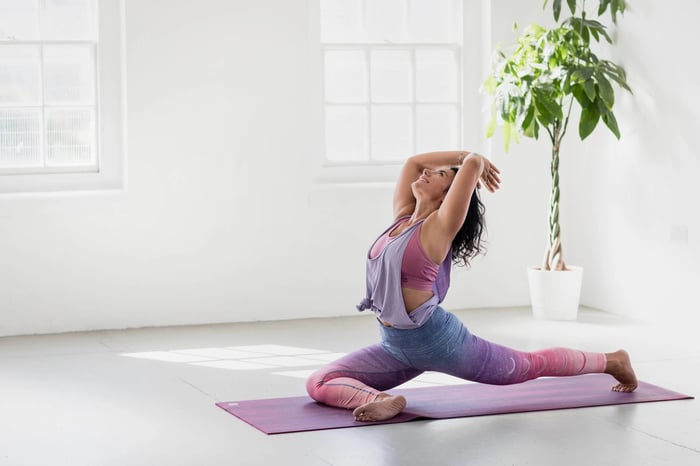
Why to avoid: Deep external rotation can stress unstable hips or aggravate hip bursitis.
2. Full Lotus or Half Lotus
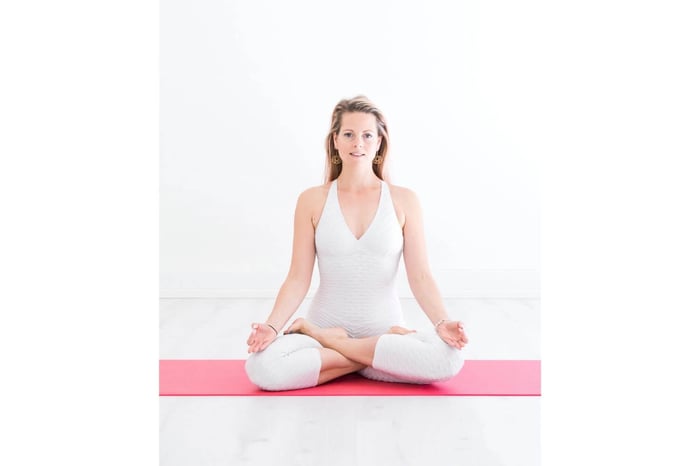 Why to avoid: Extreme rotation at the hip joints can lead to strain or flare-ups.
Why to avoid: Extreme rotation at the hip joints can lead to strain or flare-ups.
3. Deep Squat (Malasana)
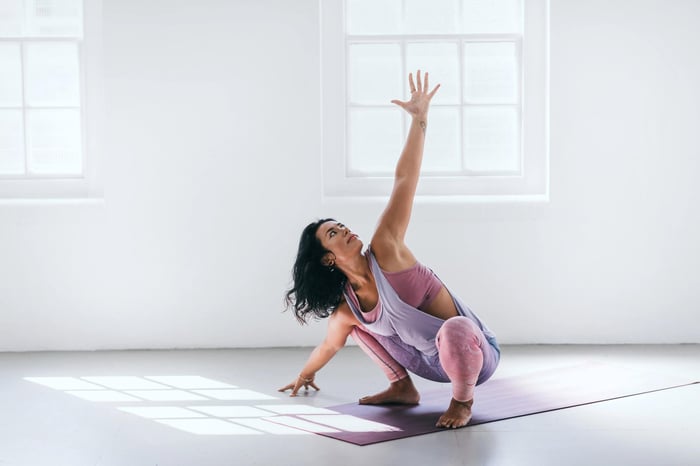
Why to avoid: May worsen hip impingement or irritate the labrum.
4. High Lunge (overly deep)
Why to avoid: Can feel unstable and overly intense on tight hip flexors or weak glutes.
5. Cow Face Pose (Gomukhasana)
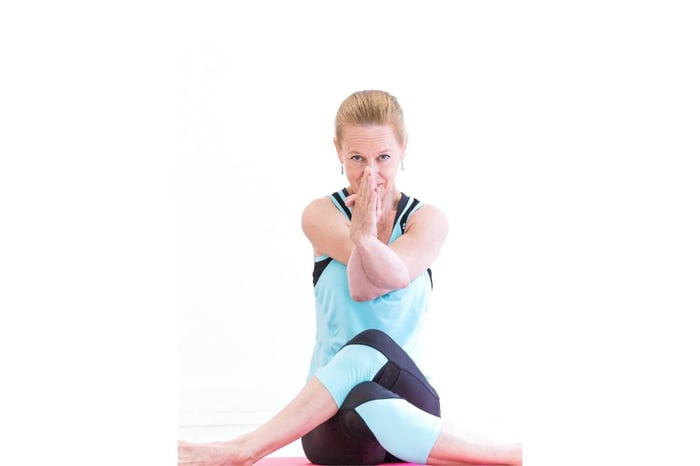
Why to avoid: Demands strong internal and external hip rotation, and may not feel safe.
6. Revolved Lunge Twist
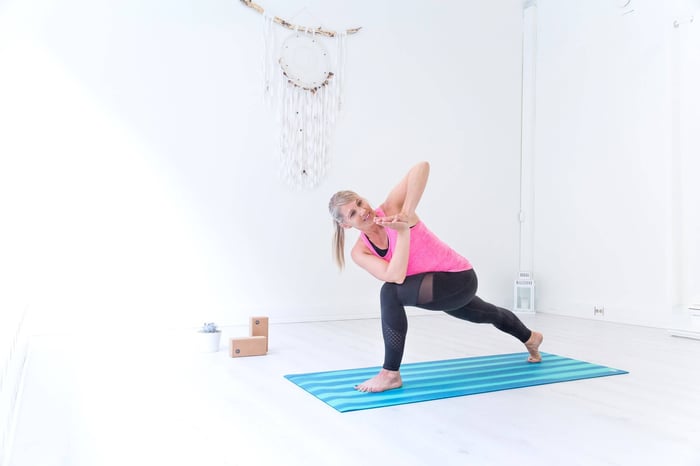 Why to avoid: Twists under load can torque the hips and spine too aggressively.
Why to avoid: Twists under load can torque the hips and spine too aggressively.
Precautions to Take Before You Start
People often jump into yoga for hip pain, hoping that deep stretches or powering through discomfort will finally bring relief. But these are common mistakes to avoid:
Forcing through pain:
Never ignore sharp pain, numbness, or a sudden sense of hip or joint instability. These signs mean you should stop immediately, as pushing through can lead to serious injury or make pain worse.
Holding poses too long for a “deeper release”:
Staying in a stretch until it hurts won’t magically loosen tight hip muscles, and could overstretch or strain them, especially if you have hip joint issues or instability.
Confusing effort with strain:
There’s a big difference between challenging your hip muscles and simply gritting your teeth through discomfort. Aim for steady engagement in each pose, not pain.
Skipping proper alignment and modifications:
Poor form and neglecting props only adds stress to hip joints and supporting muscles.
Because the hips and lower back are so closely connected, it’s common to feel tension in both areas. If that’s you, these 13 lower back stretches can offer even more support when combined with other hip-focused exercises.
Conclusion
Caring for your hips starts with listening to your body, not pushing through pain. With just a bit of time and space, you can use yoga to gently ease hip tension and build real strength and support for daily life. The best part is that you don't need any special gear or long sessions for that.
Ready to start? You can check out our Happy Hips video for a beginner-friendly routine. And if you'd like to explore further, sign up on Yogaia to join live classes and access other resources that are designed to help you move better, feel healthier, and build a consistent yoga routine.
